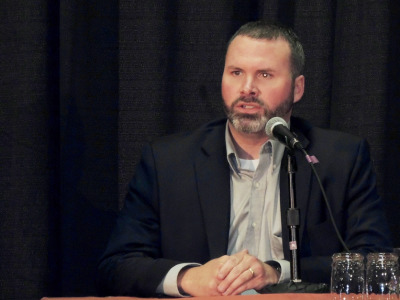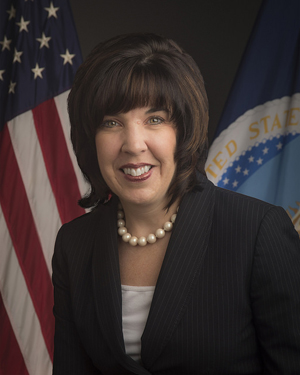WASHINGTON, Oct. 4, 2017 - The expanding concept of “rural infrastructure” was front and center Tuesday when the Farm Foundation gathered a panel of speakers from the agriculture, transportation and equipment sectors.
With the need to hike infrastructure investments rising on the national agenda, participants were all looking at much more than another “highway bill,” for decades the primary vehicle to supply federal dollars for highways, bridges, transit systems and other transportation facilities.
Robbie Boone, vice president of government affairs for the Farm Credit Council (representing the Farm Credit System), went down a list of priorities for insuring a healthy infrastructure for rural America. They include new investments in roads and bridges in the next highway bill, of course, but also nationwide broadband access, rural health care, water supply systems, finance for rural and agricultural growth, and rural housing. Plus, he says there is about $8.4 billion in deferred maintenance of the nation’s agricultural research facilities that requires catch-up investment if U.S. agriculture is going to remain competitive.
Boone was speaking for the FCC but also for the recently formed Rebuild Rural Coalition, a network of 220 organizations, companies and others linked to agriculture and rural communities.
Adrian Jahna, a citrus expert with BASF who attended Tuesday’s forum with a University of Florida group, said Florida research facilities will be among those in greatest need of rebuilding. His group, from the UF Wedgworth Leadership Institute, was in Washington to lobby for disaster funding for research centers and farms hit recently by Hurricane Irma and earlier storms. Citrus and other crop research has been seriously set back, so short-term help is needed to repair recent damage, and long-term funding will be needed to replace aged research facilities, he said.
“It’s not like the storm (Irma) hit a particular ag area. It hit the whole state,” he said.
On the national picture, Boone said that with 74 percent of America’s bridges and 73 percent of its roads in rural areas, transportation funding is critical. But he also argued that because 80 rural hospitals have had to close since 2010, and an additional 673 are economically squeezed and vulnerable, investment in rural healthcare facilities is vital as well.
Sitting beside Boone on the panel was Nick Tindall, who heads agricultural policy strategy for the Association of Equipment Manufacturers. AEM has pressed government and industry leaders in recent years to step up the nation’s infrastructure investments. Like Rebuild Rural Coalition, AEM has a lot more than roads and bridges in mind.
With the timely and efficient shipment of vehicles, equipment, tools and components at stake, AEM’s new report, The U.S. Infrastructure Advantage, calls for more grants and incentives to improve intermodal – ship to train to truck – facilities to relieve transport bottlenecks. It emphasizes the need for development and adoption of smart technology to make such improvements in the speed and cost of shipping among the modes of land and water transport.

Nick Tindall, AEM
The AEM report also emphasizes the need for improved “rural-urban connectivity” by way of rural communities’ access to broadband to take advantage of high speed communications, autonomous transportation, and sensing technology on farms and in other industries.
“People don’t think that cornfields and soybean fields need a wireless signal,” Tindall said. But farmers need high-speed wireless service on their tractors and other equipment to utilize their farming technology, and tractors without broadband connections will be at an increasing disadvantage, he said.
The desire to invest in rural connectivity is broad based. Congressional Democrats, for example, noting that 23 million rural Americans don’t have high speed internet service, recently proposed federal spending of $40 billion in their “Better Deal” economic plan to make broadband available coast to coast.
Meanwhile, Jannine Miller, senior advisor on rural infrastructure to Agriculture Secretary Sonny Perdue, said Perdue’s recent appointment of Anne Hazlett as assistant to the secretary for Rural Development within his office (rather than an undersecretary, as in previous administrations) would “elevate” RD programs such as loans and grants for rural broadband. Such programs “will be an even more important set of activities at USDA” than in the past, she said. Loan and grant application processes can be streamlined, she said, and USDA expects to award the various kinds of grants in “a holistic way” to achieve the best results for rural communities.

Anne Hazlett, USDA
Especially on the heels of President Trump’s recent indications that he’ll abandon his plan for $1 trillion in infrastructure investments (with $800 billion of that total coming from private investors), the speakers expressed little confidence on the sources of future infrastructure funding.
Boone’s coalition has pressed the White House for assurances that rural needs will get a fair share of whatever Trump proposes overall, and he said perhaps “up to 25 percent would be the rural piece” of the president’s plan.
Tindall drew a picture of fiscal desperation where transportation infrastructure financing is concerned. He noted the huge sums Congress borrowed from the Federal Reserve to pay for the 2015 highway bill now being implemented. Because fuel taxes, the primary funding source traditionally, have become so inadequate, Congress “cleared the deck of all the (financing) gimmicks,” he said. Now, “the Highway Trust Fund is nowhere near where it needs to be” to maintain the nation’s roads, and new funding sources will have to be part of the picture, he said.
#30
For more news, go to www.Agri-Pulse.com


